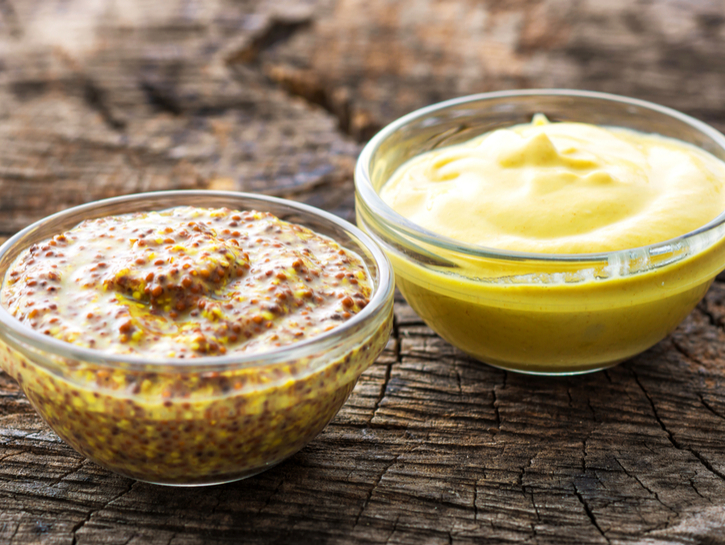Mustard is a versatile condiment that can be used for much more than just sandwiches and hot dogs, especially if you expand beyond the basic types. While the well-known bottle of yellow mustard is great, there are many more mustard varieties out there, and they are definitely worth incorporating into your diet.
Mustard Seeds

Mustard is made from the tiny, hard seeds of the mustard plant, called mustard seeds. When these seeds are ground and mixed with a liquid, such as vinegar or lemon juice, the condiment we know and love as mustard is born. There are three types of mustard seeds: yellow (also known as white), brown and black. The yellow seeds have a more mild flavor, while the brown and black seeds are more intense. Depending on which seed is used, which liquid is used and the temperature of the liquid in which the mustard is made, the final product will have more or less pungency. If you make mustard with hot temperatures and acidic liquids such as vinegar, you’ll end up with less pungent mustard. On the flip side, making mustard with cold temperatures and fewer acidic liquids like water, you’ll end up with much more pungent mustard.
The Classic Mustards
Yellow Mustard
Yellow mustard is one of the most common mustards and was first introduced to the U.S. during the St. Louis World’s Fair in 1904. French’s Classic Yellow Mustard was served with hotdogs and has been a popular food pairing ever since. Along with hot dogs, yellow mustard is often used on burgers and sandwiches to add some zest.
Dijon Mustard

Diana Taliun/Shutterstock
Dijon mustard is another classic. Named after the French village where it was first made in the 1600s, it is typically made with brown mustard seeds, though black seeds are sometimes used as well. The flavor of Dijon mustard is a bit more complex and spicy than the more mild yellow mustard, though it has a similar smooth consistency. Like the other classic mustards, it’s great on burgers and hot dogs, but it’s sharpness also makes it ideal to add to salad dressings, marinades and barbecue sauces.
Spicy Brown Mustard
Made with the spicier brown mustard seeds, spicy brown mustard has a kick to it. It can be used interchangeably with yellow and Dijon mustards , but expect the results of your food to be hotter. It is a favorite choice when paired with deli meats such as corned beef and pastrami on rye bread.
The Coarse Mustards
Creole Mustard
This type of mustard is popular throughout the south, particularly in Louisiana. Creole mustard is much spicier than the classic yellow or Dijon varieties, and typically includes horseradish that gives it an extra kick. It’s tasty when used on sandwiches or spread on meats such as chicken or pork.
Stone Ground Mustard
Stone ground mustard is typically made with brown mustard seeds that are ground less finely, so it thicker and has a coarser texture than the classic mustards. The mustard tends to be rich in flavor, sometimes with a bite of spice. This mustard can take sandwiches to the next level, especially when used on dark breads and aged cheeses, and is also great with hearty meats and in marinades.
Whole Grain Mustard

Andras Kiraly/Shutterstock
Whole grain mustard has even more texture than the Creole and stone ground varieties because it uses whole mustard seeds instead of grinding them down.. This grainy texture and rich flavor can be a great addition to potato salads, salad dressings and barbeque sauces.
Wine And Beer Mustards
Mustards made with wine are often similar to Dijon mustard, though instead of just using any old white wine, these mustards use specific types of wine to give a distinct flavor. Beer is more typically added to coarser mustards to provide them with a complex taste and texture profile. These ingredients are either added to the primary liquid used, either vinegar or water, but sometimes the water or vinegar is completely replaced by the wine or beer. Some of the favorite types of wine used to make mustards are pinot noir and champagne, while some of the popular beers are ales and porters.
The Non-French International Mustards
English Mustard
With its bright yellow color, English mustard looks just like traditional American yellow mustard. But there is a crucial difference: it is much, much spicier. One of the most popular English mustard brands is Colman’s, and is a popular condiment for sandwiches and roasts if you love heat.
Chinese Mustard
Even hotter than English mustard is Chinese mustard. It’s made by whisking dry mustard with very cold water, which amplifies its heat when served. If your sinuses can handle it, this is a great mustard to use with chicken wings and other meats.
German Mustard

Brent Hofacker/Shutterstock
German mustards are similar to Dijon, but can come in a wide variety of textures, flavors and levels of spice. Spicier German mustards are usually made with horseradish, while sweeter German mustards are typically made with brown sugar.They are an excellent condiment for pretzels and cured meats.
Sweet Mustards
Honey Mustard
Honey mustard is creamy and sweet, both attributes because of the honey ingredient. It’s great to use for barbeque sauces, salad dressings, sandwiches and dips.
Sweet Hot Mustard
Sweet hot mustards, also called hot and sweet mustards, often get their heat naturally from the way they are made rather than from adding a spicy ingredient. However, the sweetness is added with anything from brown sugar to honey. This tangy mustard is excellent on grilled and cured meats.
